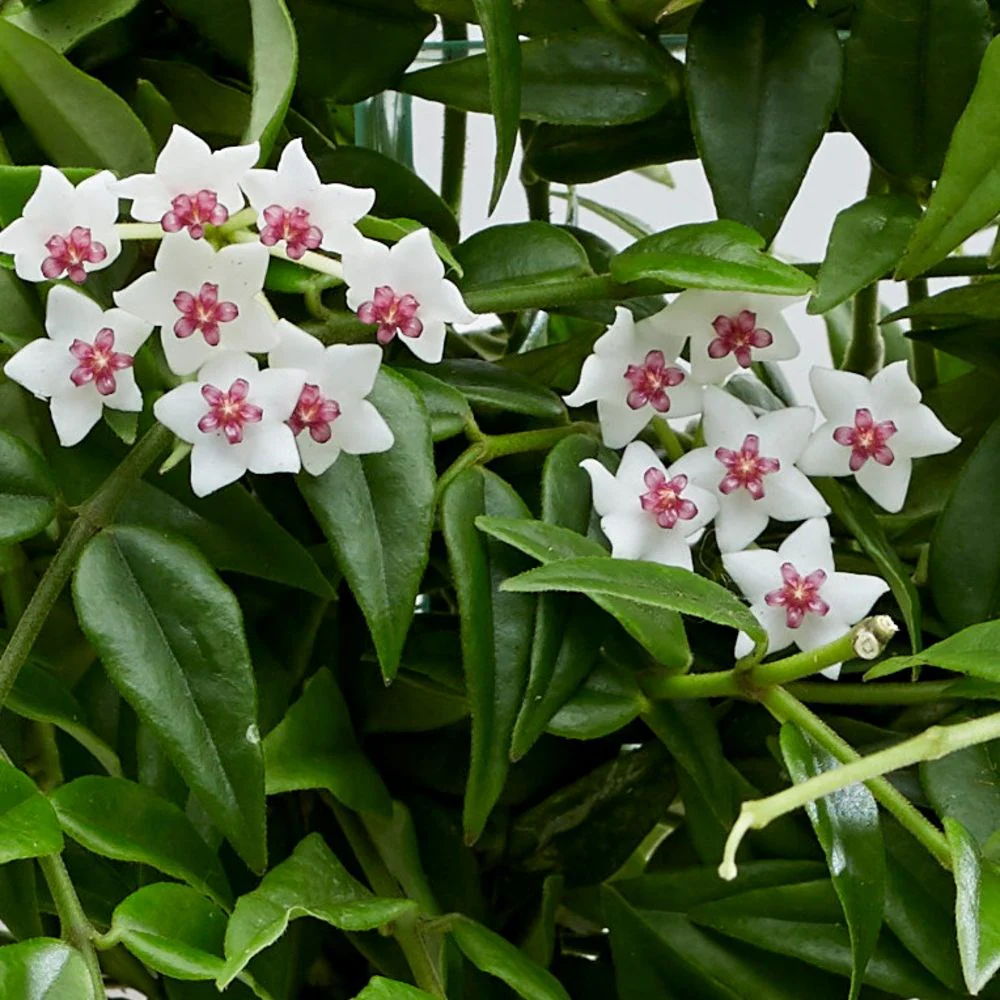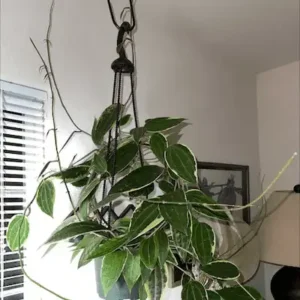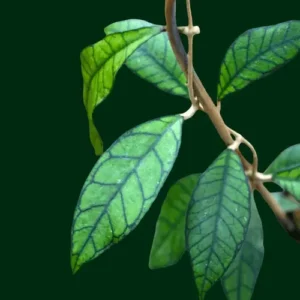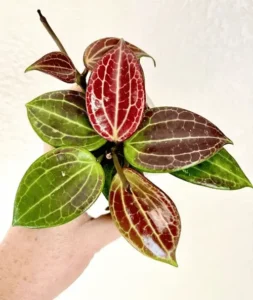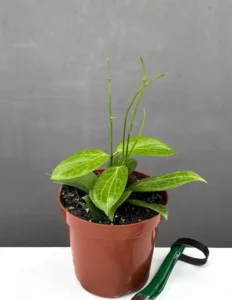In this detailed guide, we will cover everything you need to know about Hoya Bella plant care—from its origins and appearance to optimal growing conditions, propagation techniques, and solutions to common problems. The Hoya Bella, commonly called the beautiful waxflower, is a delightful plant native to Southeast Asia. Its delicate white and pink star-shaped flowers and lush, trailing vines make it a popular choice for indoor gardening enthusiasts. This plant, a member of the Hoya genus, is often considered one of the most manageable and rewarding Hoyas to grow. Known for its low-maintenance nature and resilience, the Hoya Bella is perfect for both beginners and seasoned plant lovers alike.
Overview of Hoya Bella
Botanical Information
- Scientific Name: Hoya Bella
- Common Names: Hoya Bella, Beautiful Hoya, Waxflower, or Pretty Waxflower
- Family: Apocynaceae
- Origin: Southeast Asia, particularly India, Thailand, and surrounding regions
Hoya Bella is a compact, bushy species of Hoya that can grow up to 12-18 inches (30-45 cm) tall. Unlike some of its trailing relatives, it has an upright, shrubby growth habit, making it well-suited to both hanging baskets and small pots. The plant features clusters of star-shaped flowers, each with a white or creamy outer petal and a central pinkish-red crown.
Light Requirements
Light is crucial for Hoya Bella’s overall health and flower production. In their natural habitat, Hoyas grow as epiphytes in the dappled light beneath tree canopies. Mimicking this environment is essential for success.
-Bright, indirect light
Hoya Bella thrives best in bright, indirect sunlight. Avoid placing it in direct sunlight for extended periods, as this can scorch its leaves. This is the most important requirement for Hoya Bella plant care.
-Filtered light
East-facing windows are ideal, as they provide less intense morning sunlight. West-facing windows can work if the plant is shielded from the harsh afternoon sun with a sheer curtain.
-Artificial lighting
In low-light environments, supplement natural light with grow lights. Hoya Bella can adapt to lower light levels, but flowering will be reduced.
Tip: Rotate your plant occasionally to ensure even light exposure on all sides.
Temperature and Humidity
Hoya Bella is relatively adaptable, but to thrive, it prefers a warm and humid environment.
-Ideal temperature range
Keep your plant in a temperature range of 60-80°F (15-27°C). Avoid sudden temperature changes or drafts, as they can stress the plant.
-Humidity
Native to tropical regions, Hoya Bella loves humidity. Aim for a humidity level of 50-60%, although it can tolerate lower humidity if necessary. Use a humidifier or place a water tray with pebbles near the plant to raise humidity.
-Winter care
If you live in a colder climate, be mindful that Hoya Bella is not frost-tolerant. Keep it away from windowsills or drafty areas during the winter.
Watering Routine
One of the key elements of Hoya Bella care is proper watering. Hoyas, including Bella, prefer to dry out between watering sessions.
-Watering frequency
Water the plant thoroughly when the top 1-2 inches of soil feel dry to the touch. In general, watering every 7-10 days during the growing season (spring and summer) should suffice. During the dormant months (fall and winter), reduce watering frequency.
-Well-draining soil
Hoya Bella is susceptible to root rot, so it’s essential to use a well-draining potting mix. A mix that contains equal parts peat, perlite, and orchid bark works well. The key is to avoid waterlogged soil, as the plant’s epiphytic roots are sensitive to excess moisture.
-Water quality
If possible, use distilled or rainwater, as tap water with high mineral content can accumulate in the soil and cause leaf discoloration.
Tip: Water the plant early in the day so that excess moisture can evaporate before nightfall, preventing fungal issues.
Soil and Potting Mix
Hoya Bella, like most Hoyas, prefers a loose, airy soil mix that mimics the epiphytic environments they naturally grow in. A well-draining, light soil mix allows oxygen to reach the roots and prevents the water from sitting at the root zone, which is crucial for the plant’s health.
-Recommended potting mix
A combination of orchid bark, perlite, and peat moss or coco coir makes an ideal potting mix for Hoya Bella. You can also use a pre-mixed orchid or cactus potting soil and amend it with extra perlite.
-Repotting frequency
Hoya Bella prefers to be slightly root-bound, so it doesn’t need frequent repotting. Repot every 2-3 years or when you notice roots coming out of the drainage holes.
Tip: When repotting, choose a pot that is only slightly larger than the current one to avoid overwatering issues.
Fertilization
Hoya Bella benefits from regular fertilization during its active growing season (spring and summer), but it is not a heavy feeder.
-Fertilizer type
Use a balanced, water-soluble fertilizer (such as a 10-10-10 or 20-20-20 formula) diluted to half strength. An orchid fertilizer with a higher phosphorus content can also encourage more prolific flowering.
-Fertilization frequency
Feed the plant once every 4-6 weeks during the growing season. Avoid fertilizing during the fall and winter months when the plant is in its resting period.
Tip: Rinse the soil every few months to prevent salt buildup from the fertilizer.
Flowering and Encouraging Blooms
One of the main attractions of the Hoya Bella plant is its beautiful, fragrant flowers. Under optimal conditions, your plant can produce clusters of star-shaped blooms multiple times a year.
-Flowering conditions
To encourage flowering, provide the plant with plenty of bright, indirect light and proper humidity. The plant may bloom more frequently in warm, humid environments.
-Do not remove peduncles
The flowers grow on peduncles (flower stems) that will rebloom over time, so avoid cutting them off after the blooms fade.
-Rest period
Hoyas often need a rest period in the cooler months, during which they may not produce flowers. This dormancy is normal, and growth and blooming will resume in the spring.
8. Pruning and Maintenance
Hoya Bella is a relatively low-maintenance plant when it comes to pruning. However, occasional trimming is necessary to keep the plant healthy and encourage bushier growth.
-Pruning
Prune the plant in early spring before the growing season begins. Trim back any leggy, tangled vines, or unhealthy leaves. Light pruning helps to shape the plant and promote denser foliage.
-Cleaning leaves
Wipe the leaves occasionally with a damp cloth to remove dust and allow for better photosynthesis.
9. Propagation Methods
Propagating Hoya Bella is relatively simple and can be done through stem cuttings. The best time to propagate is during the growing season in spring or summer.
-Stem cuttings
Take a cutting that includes at least two nodes and a pair of leaves. Dip the cut end in rooting hormone and plant it in a moist potting mix.
-Water Propagation
You can also root Hoya Bella in water. Place the cutting in a glass of water, ensuring the nodes are submerged. Once roots develop (in 2-4 weeks), transfer the cutting to a pot with soil.
-Propagation Tips
Provide high humidity and consistent warmth to encourage root growth. A clear plastic bag over the cutting can help create a humid environment. This is the most important requirement for Hoya Bella plant care.
Common Pests and Diseases
Hoya Bella is generally resistant to pests and diseases, but it can still fall victim to common houseplant pests if not properly cared for.
-Mealybugs
Mealybugs are the most common pests that affect Hoya Bella. These small, cotton-like pests can be found on the leaves and stems. Use insecticidal soap or neem oil to treat the plant if you notice an infestation.
-Spider mites
Spider mites thrive in dry conditions, so keeping the humidity levels high can help prevent them. Wipe down leaves with a damp cloth and spray neem oil if mites appear.
-Root rot
Overwatering is the most common cause of root rot in Hoya Bella. Always check that the soil is dry before watering and ensure the pot has good drainage.
Tip: Regularly inspect your plant for signs of pests or disease, especially during the warmer months when infestations are more likely.
Hoya Bella: Special Considerations
While Hoya Bella is generally easy to care for, there are a few special considerations to keep in mind:
-Pet safety
Hoya Bella is considered non-toxic to pets, making it a great choice for households with cats and dogs. However, it’s always best to discourage pets from chewing on plants.
-Aesthetic placement
Due to its compact and trailing nature, Hoya Bella looks stunning in hanging baskets or displayed on a shelf. Its trailing vines add a lush, green element to any space.
Troubleshooting Common Problems
Even with the best care, you may encounter a few issues when growing Hoya Bella. Here are some common problems and their solutions:
-Yellowing leaves
This is often a sign of overwatering. Check the moisture level in the soil and adjust your watering schedule accordingly.
-No blooms
If your Hoya Bella is not flowering, it may not be receiving enough light. Move it to a brighter location and consider using a bloom-boosting fertilizer.
-Leggy growth
Leggy growth usually occurs when the plant is not receiving enough light. Trim back the leggy stems and move the plant to a location with brighter, indirect light.
FAQs How do you take care of a Hoya bella plant? Provide bright, indirect sunlight with stable room temperatures of 60-80°F (15-27°C) and indoor humidity below 60 for enough growth. Provide soluble fertilizer high in phosphorus as it encourages blooms. How much light does a Hoya Bella need? Hoya Bella needs bright, indirect sunlight with indoor humidity below 60. It thrives best in indirect sunlight. In case of direct sunlight, hoya bella will die. Is Hoya Bella easy to grow? Hoya Bella is easy to grow which makes it a suitable choice for any indoor collection. It thrives in bright, indirect sunlight and moderate watering levels, making its maintenance relatively straightforward. |
Conclusion
Hoya Bella is a charming and easy-to-care-for plant that brings a touch of tropical beauty into any home. With its fragrant flowers, trailing vines, and low-maintenance nature, it’s no wonder that the waxflower is a favorite among plant enthusiasts. By providing the right conditions—bright, indirect light, proper watering, and occasional fertilization—you can enjoy this plant’s unique beauty for years.
Whether you’re a seasoned plant parent or just beginning your indoor gardening journey, Hoya Bella is a rewarding addition to your plant collection. Follow this guide, and your Hoya Bella will flourish, offering the delightful sight and smell of its stunning blooms.

